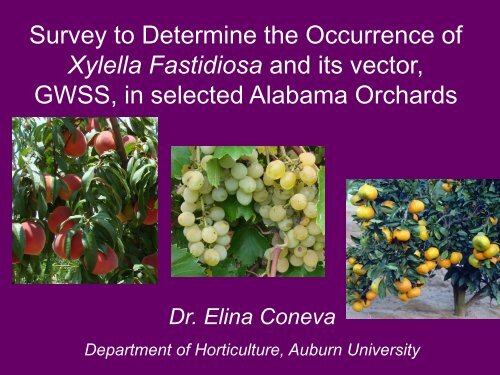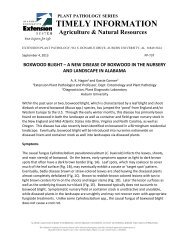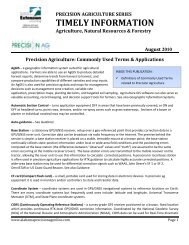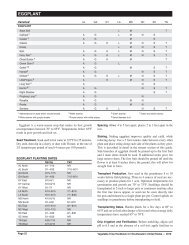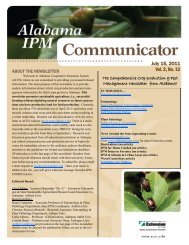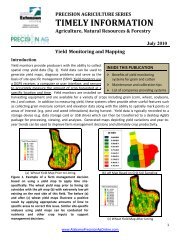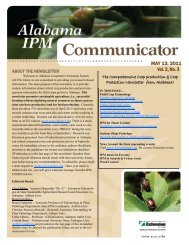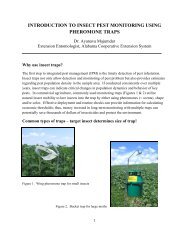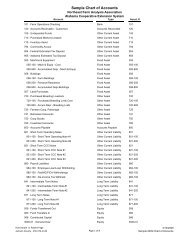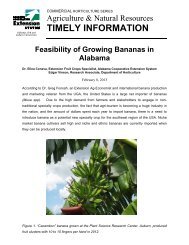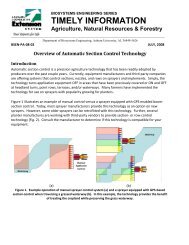Survey to Determine the Occurrence of Xylella Fastidiosa and its ...
Survey to Determine the Occurrence of Xylella Fastidiosa and its ...
Survey to Determine the Occurrence of Xylella Fastidiosa and its ...
You also want an ePaper? Increase the reach of your titles
YUMPU automatically turns print PDFs into web optimized ePapers that Google loves.
<strong>Survey</strong> <strong>to</strong> <strong>Determine</strong> <strong>the</strong> <strong>Occurrence</strong> <strong>of</strong><br />
<strong>Xylella</strong> <strong>Fastidiosa</strong> <strong>and</strong> <strong>its</strong> vec<strong>to</strong>r,<br />
GWSS, in selected Alabama Orchards<br />
Dr. Elina Coneva<br />
Department <strong>of</strong> Horticulture, Auburn University
Acknowledgements<br />
M.S. C<strong>and</strong>idate Xing Ma<br />
Dr. John Murphy<br />
Dr. Henry Fadamiro<br />
ACES:<br />
Bobby Boozer<br />
Jim Pitts<br />
Larry Wells<br />
Grower Co-opera<strong>to</strong>rs:<br />
Ken Buck<br />
Allan Norden<br />
Jimmy Witt<br />
John Neighbors<br />
Bob Helms<br />
Wes Isom
What is <strong>Xylella</strong> fastidiosa<br />
Xylem-limited Bacterium<br />
<strong>Xylella</strong> fastidiosa in infected plum tree<br />
(Latham <strong>and</strong> Nor<strong>to</strong>n, 1980)<br />
X. f. bacteria in <strong>the</strong> water-conducting cells<br />
(xylem) <strong>of</strong> a grape leaf vein
How X.f. Bacterium Affects <strong>the</strong> Plant<br />
‣ Moves in plant xylem systematically<br />
‣ Multiplies<br />
‣ Accumulates<br />
‣ Form a bi<strong>of</strong>lim in <strong>the</strong> susceptible hosts<br />
‣ Plug <strong>the</strong> xylem vessel <strong>of</strong> <strong>the</strong> plant
Disease Significance<br />
‣ Plant diseases caused by <strong>Xylella</strong> fastidiosa have<br />
emerged as some <strong>of</strong> <strong>the</strong> most significant new disease<br />
threats in Americas<br />
‣ X. f. has a wide range <strong>of</strong> hosts<br />
‣ Introduction <strong>of</strong> new strains <strong>of</strong> X. f. resulted in new<br />
host-pathogen combinations - Citrus Variegated<br />
Chlorosis (1980s)<br />
‣ There is no known cure
FRUIT CROP HOSTS<br />
‣ Bunch grapes - Pierce’s Disease (PD) in <strong>and</strong> contributed<br />
<strong>to</strong> <strong>the</strong> outbreak <strong>of</strong> PD in CA vineyards in <strong>the</strong> 1990s<br />
‣ Plums - Plum leaf scald - one <strong>of</strong> <strong>the</strong> most serious<br />
diseases limiting <strong>the</strong> production <strong>of</strong> plums in AL (Latham<br />
<strong>and</strong> Nor<strong>to</strong>n, 1980)<br />
‣ Peaches - Phony peach occurs in <strong>the</strong> Coastal Plain<br />
from NC <strong>to</strong> Texas<br />
‣ Citrus – Citrus Variegated Chlorosis (CVC) found in<br />
Brazil in 1987; 2 million citrus trees affected 5 yrs later<br />
‣ Blueberry - Blueberry leaf scorch found in GA in 2006
SYMPTOMS ON GRAPE<br />
• Leaf necrosis<br />
• Dieback<br />
• “Match stick”
SYMPTOMS ON PLUM<br />
‣ Leaf marginal<br />
necrosis<br />
‣ Death <strong>of</strong> entire<br />
branches
SYMPTOMS ON PEACH<br />
‣ Stunted growth<br />
‣ Dark green canopy<br />
‣ Flat <strong>to</strong>p<br />
‣ Small fruit
SYMPTOMS ON CITRUS<br />
Small infected fruit<br />
compared with<br />
normal fruit<br />
Leaf interveinal chlorosis
SYMPTOMS ON BLUEBERRY<br />
Marginal leaf burn<br />
<strong>and</strong> scorch<br />
Yellow stems after<br />
leaf abscision<br />
Similar <strong>to</strong> anthracnose<br />
leaf spot
Disease Transmission<br />
‣ Pruning <strong>to</strong>ols<br />
‣ S<strong>to</strong>ck <strong>to</strong> scion<br />
‣ Vec<strong>to</strong>rs: Xylem-feeding<br />
leafhoppers
Glassy-Winged Sharpshooters (GWSS)<br />
‣ 28 species are confirmed vec<strong>to</strong>rs<br />
‣ Strong flyer<br />
‣ Feed on different plant<br />
‣ Feeding on woody part <strong>of</strong> grapes
OBJECTIVES<br />
‣ <strong>Survey</strong> <strong>the</strong> presence <strong>and</strong> occurrence <strong>of</strong> <strong>Xylella</strong><br />
fastidiosa in commercially important fruit crops in<br />
Alabama<br />
‣ Identify <strong>the</strong> vec<strong>to</strong>r species <strong>and</strong> estimate <strong>the</strong><br />
seasonal dynamics <strong>of</strong> glassy-winged sharpshooter in<br />
selected AL locations
Site Selection for<br />
Plant Tissue Sampling<br />
‣ 21 orchards sampled 3 X<br />
‣ Fruit Crops:<br />
- Peach<br />
-Plum<br />
- Satsuma m<strong>and</strong>arin<br />
- Bunch grapes<br />
- Muscadines
Insect Sampling<br />
Three locations were selected<br />
<strong>to</strong> determine <strong>the</strong> insect<br />
- identity;<br />
- abundance;<br />
- seasonal dynamics
‣ Four yellow sticky traps per crop<br />
‣ Collected on bi-weekly intervals April - Oc<strong>to</strong>ber
RESULTS<br />
‣ Less than 1% peach <strong>and</strong> plum samples infected<br />
‣ 50% <strong>of</strong> bunch grapes infected
%<br />
50<br />
10<br />
100
100%<br />
80%
Glassy-Winged Sharpshooter Species<br />
Homalodisca vitripennis Homalodisca insolita Oncome<strong>to</strong>pia orbona
Average Number <strong>of</strong> GWSS in Three AL Locations, 2008<br />
Gulf Coast<br />
Central AL<br />
North AL<br />
‣ Gulf Coast – highest number, end <strong>of</strong> June peak<br />
‣ Central AL – low insect pressure, end <strong>of</strong> July peak<br />
‣ North AL – very low insect pressure
Average Number <strong>of</strong> GWSS Among Fruit Crops in <strong>the</strong> Gulf Coast <strong>of</strong> AL, 2008<br />
Plum - 230<br />
Muscadine - 170<br />
Satsuma - 55<br />
Peach - 37
SUMMARY<br />
‣ X. f. infected peach <strong>and</strong> plum orchards throughout <strong>the</strong> state<br />
<strong>and</strong> infected bunch grapes in Central <strong>and</strong> North AL<br />
‣ X. f. positive results from asymp<strong>to</strong>matic trees found on<br />
plum, peach, <strong>and</strong> bunch grape<br />
‣ Three GWSS species were prevalent in AL orchards<br />
‣ Gulf Coast had <strong>the</strong> highest incidence <strong>of</strong> GWSS<br />
‣ Maximum insect pressure in mid June on plum<br />
‣ The peak incidence <strong>of</strong> GWSS in Central AL occurred 40<br />
days after <strong>the</strong> peak in <strong>the</strong> Gulf Coast<br />
‣ The insect incidence in North AL was very low
THANK YOU!


